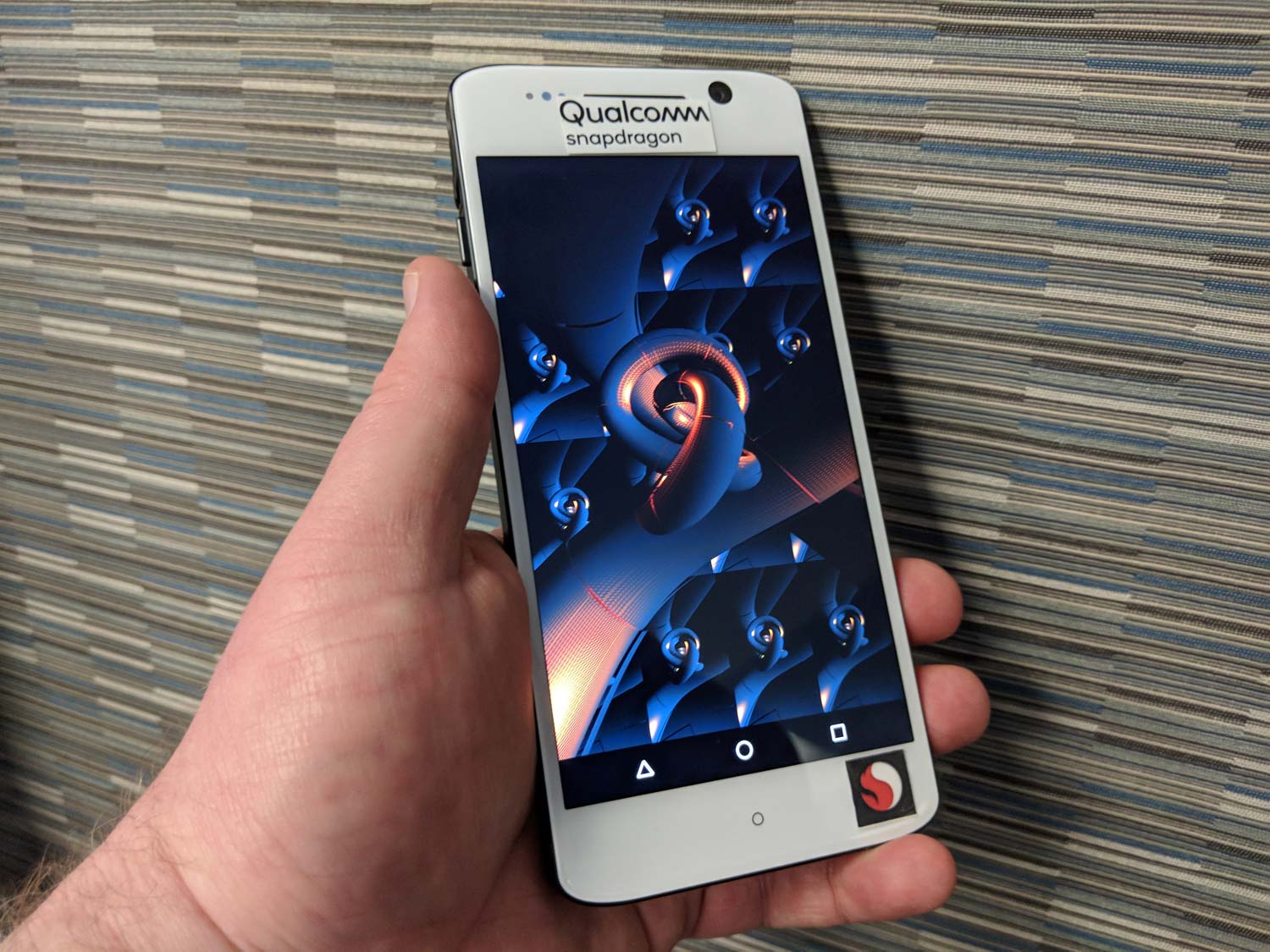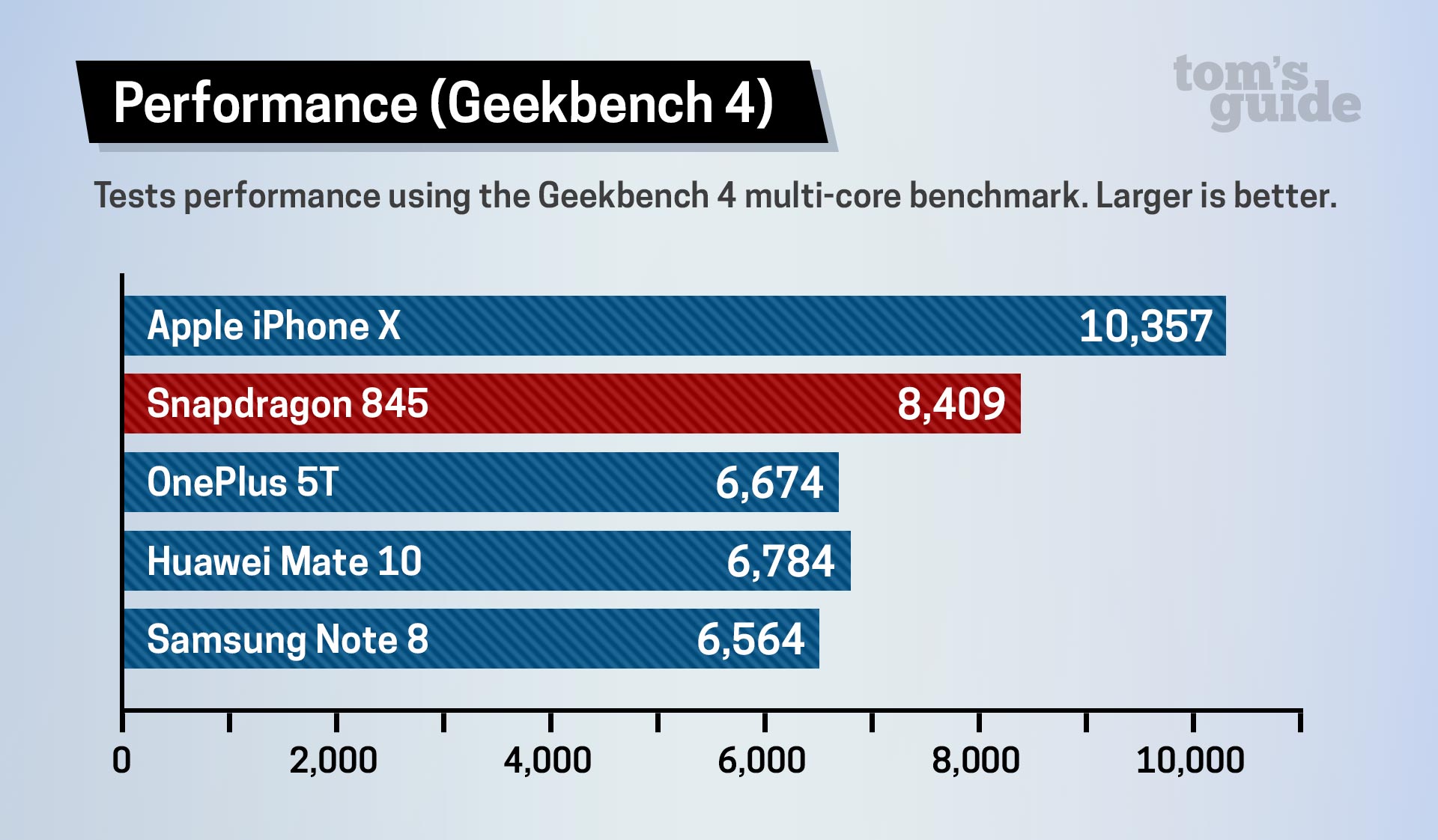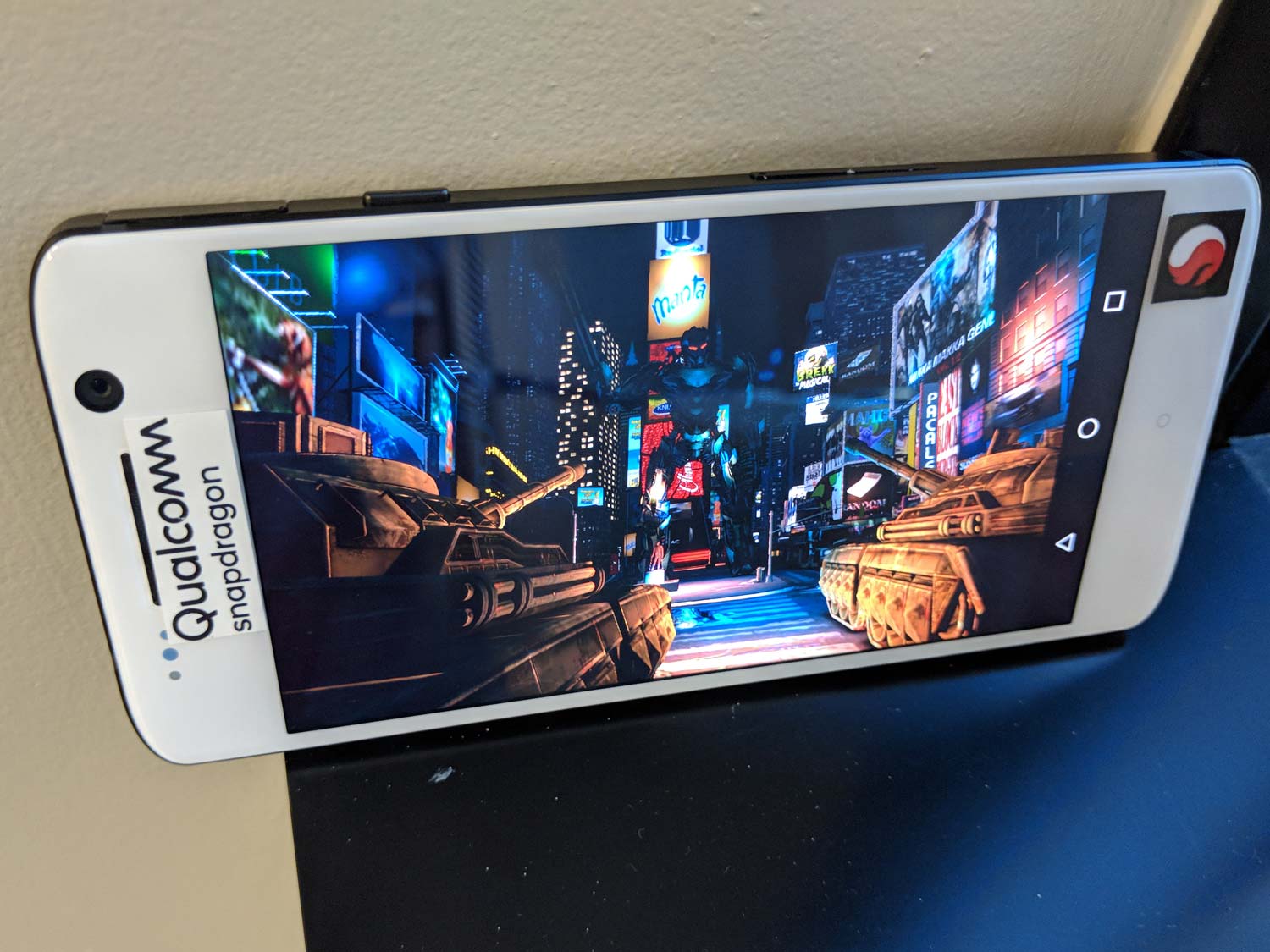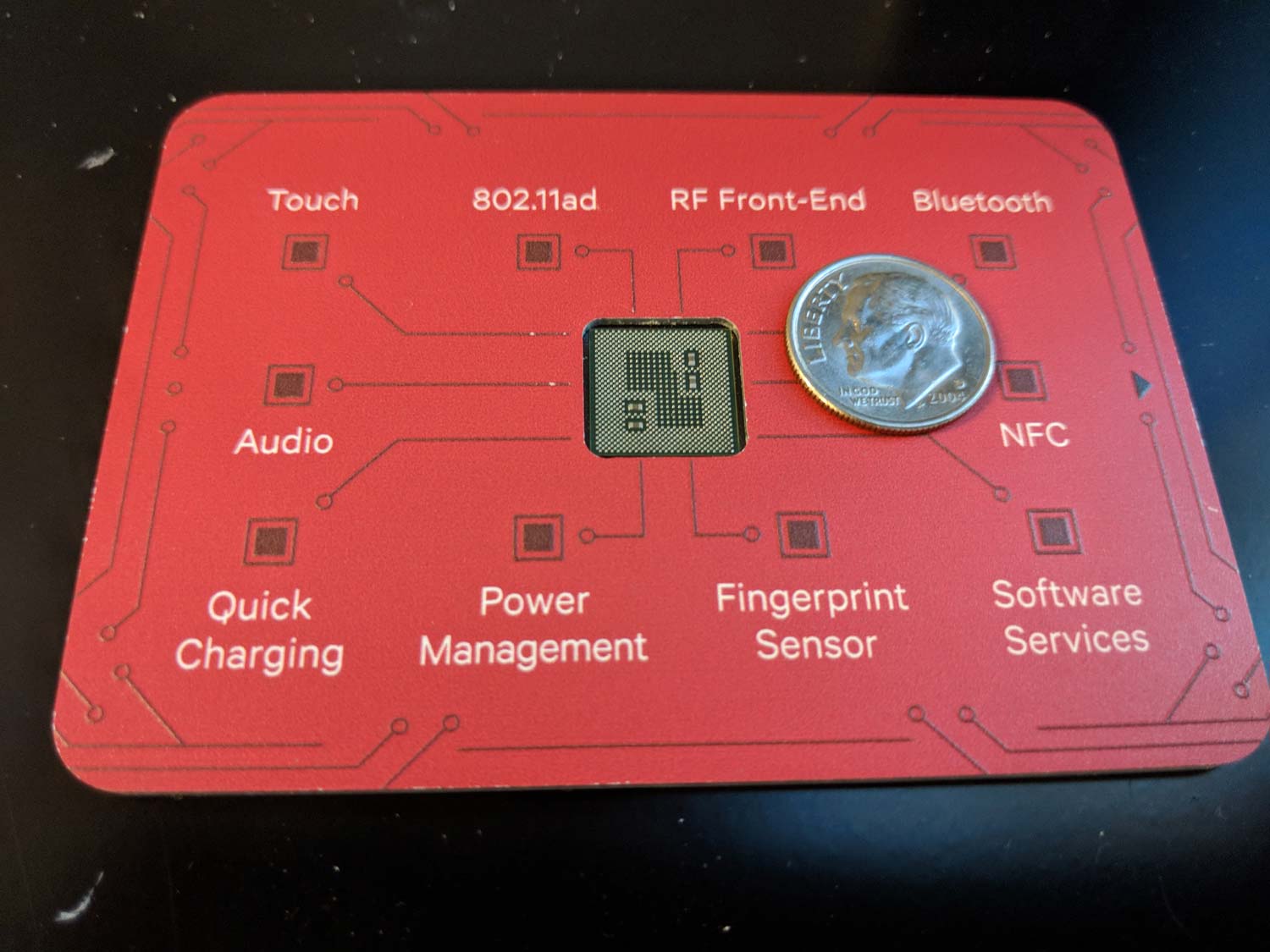Snapdragon 845 Benchmarked: Can It Match the iPhone's Power?
The A11 Bionic chip in Apple's latest iPhones still sets the speed standard, but Qualcomm's new Snapdragon 845 offers better graphics performance in our testing.
We've had a chance to benchmark the Snapdragon 845, and while the new mobile processor closes the speed gap with the A11 Bionic a little bit, Apple's blazing mobile processor is still faster. But we did see improved graphics performance from the Snapdragon 845, with Qualcomm's chip outperforming the iPhone X in some tests.

We conducted our benchmark tests at Qualcomm's headquarters, using a reference design device powered by the Snapdragon 845 mobile processing platform. (The Galaxy S9, launching Feb. 25, will reportedly feature the new Qualcomm chip.) The 5.5-inch device was loaded up with 6GB of RAM.
MORE: Snapdragon 845: What It Means for Your Next Smartphone
Since we tested on a device that will never see the light of day, the results we tallied could differ from another phone running on the Snapdragon 845, especially depending on the amount of RAM included with the phone. But these benchmarks should give us a pretty good idea of what the Snapdragon 845 will mean for mobile devices.
Overall Performance: Still No Match for A11 Bionic
Running Geekbench 4, which measures general performance, the Snapdragon 845-powered reference device recorded a multicore score of 8,409. That's a 28 percent jump from the 6,564 score we recorded when we reviewed the Snapdragon 835-powered Galaxy Note 8 last year.

Our Snapdragon 845 device also beat out Huawei's Mate 10 Pro, which runs on a Kirin 970 processor; that phone scored 6,784 when we tested it, which had been the high-water mark for Android devices.
For what it's worth, the Geekbench 4 scores we saw from the Snapdragon 845 device at Qualcomm weren't all that different from alleged Geekbench numbers that had leaked out back in December.
But Apple's iPhones have set the performance standard as of late, thanks to the A11 Bionic processor, and that's not going to change even with the arrival of the Snapdragon 845. We recorded a multicore Geekbench 4 score of 10,375 for the iPhone X. (The iPhone 8 Plus was even faster, at 10,472.)
The A11 chip also dominates with its single-core score. We recorded a single-core score of 4,055 for the iPhone 8 Plus in GeekBench — far better than the 2,449 single-core figure we saw from our Snapdragon 845-powered device.
Geekbench 4 is best at measuring short max bursts of performance, which is certainly important on a smartphone, but not necessarily the whole picture. Qualcomm would argue that the Snapdragon 845 can deliver sustained performance without also draining a lot of battery. (More on the Snapdragon 845's power management prowess in a moment.)
Sign up to get the BEST of Tom's Guide direct to your inbox.
Get instant access to breaking news, the hottest reviews, great deals and helpful tips.
Snapdragon 845 Beats iPhone on Some Graphics Tests
The Snapdragon 845 fares much better when it comes to measuring graphics performance, even besting the iPhone X in a test we ran. That would be 3DMark's Sling Shot benchmark. Our Snapdragon 845 device turned in a score of 5,964 when we ran the OpenGL ES 3.0 benchmark. Running that same test on the iPhone X back in our lab, we saw a score of 3,998. On the Sling Shot Extreme OpenGL ES 3.1 benchmark, though, the iPhone X turned in the higher number — 4,994 to the Snapdragon 845's 4,389.
The Snapdragon 845 device beat the Snapdragon 835-powered Note 8 (4,912) and OnePlus 5T (4,916) on the Sling Shot benchmark, and it bested the Mate 10 Pro and its 3,661 score, too. We also saw higher scores on the Snapdragon 845 device when we ran GFXBench 4.0.

Browser Performance
On the JavaScript-based JetStream benchmark measuring browser performance, our Snapdragon 845 device bested other Android devices with a score of 86.1. That's 30 percent better than our OnePlus 5T review unit, which includes 8GB of RAM. The iPhone X blows away Android devices here, with a score of 223, though that's a more a reflection of how the iOS platform handles JavaScript.
Qualcomm has touted some performance numbers since it unveiled the Snapdragon 845 late last year, promising a 25 percent improvement in performance uplift over the Snapdragon 835 and 30 percent improvement in graphics from the new Adreno 630 GPU. But performance is just one of what the chip maker describes as the pillars supporting its new mobile processor.

What We Can't Benchmark - Yet
The Snapdragon 845 is designed to provide greater immersion, whether through an improved image signal processor or the ability to produce smoother virtual reality experiences, offer better support for artificial intelligence, boost security with a secure processing unit adding vault-like features and improve connectivity with the new X20 LTE modem that can deliver gigabit speeds on networks where that's available.
Those aren't features we can benchmark on a reference device, though — we'll have to wait until we get our hands on a device powered by the Snapdragon 845 to see if it delivers on Qualcomm's goals.
Another aspect of the Snapdragon 845 that we weren't able to benchmark was its power-management features, though we did a see a demo that illustrates how this new mobile processor will consume less battery power. Qualcomm set up two mobile devices — one with the Snapdragon 845 and the other with last year's 835 — and had them stream 4K video at 60 frames per second. The 845-powered device consumed an average of 1.6 watts, a 20 percent improvements over the 2 watts that the 835-powered device needed.
Outlook
We'll know more about how the Snapdragon 845 handles once we get a chance to measure the performance of a shipping device. From what we've seen so far, though, the new processor looks like it's made some solid performance gains over the Snapdragon 835, even if Apple's A11 Bionic still enjoys an edge in speed.
Credit: Philip Michaels/Tom's Guide
Philip Michaels is a Managing Editor at Tom's Guide. He's been covering personal technology since 1999 and was in the building when Steve Jobs showed off the iPhone for the first time. He's been evaluating smartphones since that first iPhone debuted in 2007, and he's been following phone carriers and smartphone plans since 2015. He has strong opinions about Apple, the Oakland Athletics, old movies and proper butchery techniques. Follow him at @PhilipMichaels.
-
alex.d.salazar Umm, this is a really poor example of a one-sided argument. It is clear the author does everything they can to drive the apple product against a phone that is clearly not on the same level. And, while the author references the Galaxy 9, which is not even in the test, this is clearly not a true representation. The author is comparing apples to Oranges. I have a Galaxy Note 8 and everytime a co-worker tries to compete against it they are blown away. And, return to their inner child taking refuge in their office. I have seen a few users drop their apple in favor of a new Galaxy product. The article has an intriguing title however the comparison and article are from apple-landia since the Galaxy 9 is not even in the test. All I ask is, when an article is written, it is fair, unbiased, and that the products mentioned are actually in the test. I like to depend on "Tom's Guide" however this one article has made me feel I should seek out another site.Reply
(This comment was deliberately written in favor of the Galaxy line so the author can comprehend the other side of a one-sided argument. However, the Galaxy products do tend to out perform apple repeatedly. It is just fact) -
IRJ8 There are other steps forward with the 845 chipset. There will be a significant increase in battery efficiency of around s3% . Also the unit nativelt runs BT5.0 so the latest and BEST BT ear buds such as the Zolo Liberty Plus can be nicely used.Reply -
Kilster Reply20699622 said:Umm, this is a really poor example of a one-sided argument. It is clear the author does everything they can to drive the apple product against a phone that is clearly not on the same level. And, while the author references the Galaxy 9, which is not even in the test, this is clearly not a true representation. The author is comparing apples to Oranges. I have a Galaxy Note 8 and everytime a co-worker tries to compete against it they are blown away. And, return to their inner child taking refuge in their office. I have seen a few users drop their apple in favor of a new Galaxy product. The article has an intriguing title however the comparison and article are from apple-landia since the Galaxy 9 is not even in the test. All I ask is, when an article is written, it is fair, unbiased, and that the products mentioned are actually in the test. I like to depend on "Tom's Guide" however this one article has made me feel I should seek out another site.
(This comment was deliberately written in favor of the Galaxy line so the author can comprehend the other side of a one-sided argument. However, the Galaxy products do tend to out perform apple repeatedly. It is just fact)
As a current owner of an iPhone X, Note 8, Razer Phone and Pixel XL 2, the Note 8 is the worst performer of the bunch. I can guarantee I do not go back to refuge in my office against myself. Snappiest is iPhone X, very close to the Pixel 2 XL, which are my two main phones at the moment. -
s.bascombe72 The iPhone bionic processor is impressive but does suffer with slow down ,the snapdragon it's better in the long run I think apple always have the upper hand because it only makes for a couple of devices and across the processes are really good for Apple devices however if you put them in a Android device hey will be pretty rubbish.Reply -
s.bascombe72 I'm not sure if making a comparison with the bionic CPU really proves that much personally. I had the iPhone 8 for a while and it is very nippy, but the multitasking is not as concise as the android equivalents for definite.Reply
I think people need to remember that the bionic CPU will never power an android device or vice versa.
I now have a mate 10 pro and in the real world of use there's not much in it even though the Kirin is quite abit less powerful and doesn't suffer from much slow down compared to my apple where I had to restart it a fair few times to ensure its speedy performance.
Time will tell I think.

